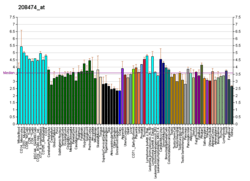CLDN6
Claudin-6 is a protein that in humans is encoded by the CLDN6 gene.[5][6][7] It belongs to the group of claudins.
References
- 1 2 3 GRCh38: Ensembl release 89: ENSG00000184697 - Ensembl, May 2017
- 1 2 3 GRCm38: Ensembl release 89: ENSMUSG00000023906 - Ensembl, May 2017
- ↑ "Human PubMed Reference:".
- ↑ "Mouse PubMed Reference:".
- ↑ Morita K, Furuse M, Fujimoto K, Tsukita S (Mar 1999). "Claudin multigene family encoding four-transmembrane domain protein components of tight junction strands". Proc Natl Acad Sci U S A. 96 (2): 511–6. doi:10.1073/pnas.96.2.511. PMC 15167. PMID 9892664.
- ↑ Meertens L, Bertaux C, Cukierman L, Cormier E, Lavillette D, Cosset FL, Dragic T (Mar 2008). "The Tight Junction Proteins Claudin-1, -6, and -9 Are Entry Cofactors for Hepatitis C Virus". J Virol. 82 (7): 3555–60. doi:10.1128/JVI.01977-07. PMC 2268462. PMID 18234789.
- ↑ "Entrez Gene: CLDN6 claudin 6".
External links
- Human CLDN6 genome location and CLDN6 gene details page in the UCSC Genome Browser.
Further reading
- Kniesel U, Wolburg H (2000). "Tight junctions of the blood–brain barrier". Cell. Mol. Neurobiol. 20 (1): 57–76. doi:10.1023/A:1006995910836. PMID 10690502.
- Heiskala M, Peterson PA, Yang Y (2001). "The roles of claudin superfamily proteins in paracellular transport". Traffic. 2 (2): 93–8. doi:10.1034/j.1600-0854.2001.020203.x. PMID 11247307.
- Tsukita S, Furuse M, Itoh M (2001). "Multifunctional strands in tight junctions". Nat. Rev. Mol. Cell Biol. 2 (4): 285–93. doi:10.1038/35067088. PMID 11283726.
- Tsukita S, Furuse M (2003). "Claudin-based barrier in simple and stratified cellular sheets". Curr. Opin. Cell Biol. 14 (5): 531–6. doi:10.1016/S0955-0674(02)00362-9. PMID 12231346.
- González-Mariscal L, Betanzos A, Nava P, Jaramillo BE (2003). "Tight junction proteins". Prog. Biophys. Mol. Biol. 81 (1): 1–44. doi:10.1016/S0079-6107(02)00037-8. PMID 12475568.
- Morita K, Sasaki H, Furuse M, Tsukita S (1999). "Endothelial Claudin: Claudin-5/Tmvcf Constitutes Tight Junction Strands in Endothelial Cells". J. Cell Biol. 147 (1): 185–94. doi:10.1083/jcb.147.1.185. PMC 2164984. PMID 10508865.
- Itoh M, Furuse M, Morita K, et al. (2000). "Direct Binding of Three Tight Junction-Associated Maguks, Zo-1, Zo-2, and Zo-3, with the Cooh Termini of Claudins". J. Cell Biol. 147 (6): 1351–63. doi:10.1083/jcb.147.6.1351. PMC 2168087. PMID 10601346.
- Turksen K, Troy TC (2001). "Claudin-6: a novel tight junction molecule is developmentally regulated in mouse embryonic epithelium". Dev. Dyn. 222 (2): 292–300. doi:10.1002/dvdy.1174. PMID 11668606.
- Kiuchi-Saishin Y, Gotoh S, Furuse M, et al. (2002). "Differential expression patterns of claudins, tight junction membrane proteins, in mouse nephron segments". J. Am. Soc. Nephrol. 13 (4): 875–86. PMID 11912246.
- Turksen K, Troy TC (2002). "Permeability barrier dysfunction in transgenic mice overexpressing claudin 6". Development. 129 (7): 1775–84. PMID 11923212.
- Morita K, Furuse M, Yoshida Y, et al. (2002). "Molecular architecture of tight junctions of periderm differs from that of the maculae occludentes of epidermis". J. Invest. Dermatol. 118 (6): 1073–9. doi:10.1046/j.1523-1747.2002.01774.x. PMID 12060405.
- Reyes JL, Lamas M, Martin D, et al. (2003). "The renal segmental distribution of claudins changes with development". Kidney Int. 62 (2): 476–87. doi:10.1046/j.1523-1755.2002.00479.x. PMID 12110008.
- Strausberg RL, Feingold EA, Grouse LH, et al. (2003). "Generation and initial analysis of more than 15,000 full-length human and mouse cDNA sequences". Proc. Natl. Acad. Sci. U.S.A. 99 (26): 16899–903. doi:10.1073/pnas.242603899. PMC 139241. PMID 12477932.
- Katoh M, Katoh M (2004). "CLDN23 gene, frequently down-regulated in intestinal-type gastric cancer, is a novel member of CLAUDIN gene family". Int. J. Mol. Med. 11 (6): 683–9. doi:10.3892/ijmm.11.6.683. PMID 12736707.
- Liu F, Koval M, Ranganathan S, Fanayan S, Hancock WS, Lundberg EK, Beavis RC, Lane L, Duek P, McQuade L, Kelleher NL, Baker MS (2015). "A systems proteomics view of the endogenous human claudin protein family". J Proteome Res. doi:10.1021/acs.jproteome.5b00769. PMID 26680015.
This article is issued from
Wikipedia.
The text is licensed under Creative Commons - Attribution - Sharealike.
Additional terms may apply for the media files.




